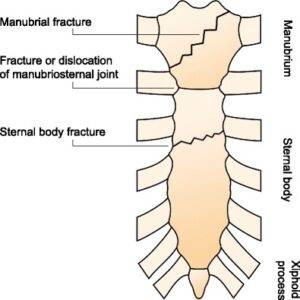47 years old woman brought to A&E by ambulance following motor vehicle accident. She was driving at 60 mph and ran into a stationary vehicle. There was significant damage to her car and air bag was deployed. She complained of pain in the anterior chest especially over sternum.
Trauma CT scans revealed isolated transverse fracture of the body of sternum. She was haemodynamically stable, and no other injuries identified on secondary survey.
What is the evidence-based management of isolated fracture sternum?
Unfortunately, there are no randomised controlled trials or standard guidelines from NICE or other professional organisation. Most of the evidence is based on observational or retrospective studies.
My learning:
Sternal fractures usually result from a high-energy direct blow to the anterior chest wall. Typically, these fractures occur during road traffic collisions when the driver’s chest strikes the steering column or rapid deceleration causes an occupant’s chest to slam against their cross-shoulder seatbelt.
Sternal fractures are rare injuries with an incidence of less than 0.5% of all fractures and an estimated 3–8% in blunt trauma patients [1]
An isolated sternal fracture is seen as a relatively benign injury [2]. The extent of sternal fracture displacement correlates with the risk for associated intrathoracic injury.
Morbidity and mortality of sternal fractures are mostly determined by concomitant injuries of internal thoracic organs and mortality rates range from 4 to 45% [3].
Common associated injuries include cranial injury (including intracranial haemorrhage), rib fracture, pulmonary contusion, spinal fracture, retrosternal hematoma, pneumothorax and haemothorax, and extremity trauma.
Investigations:
Contrast-enhanced CT of the chest and an ECG should be obtained to rule out associated injuries if a sternal fracture is diagnosed on plain film [4].
Management:
The majority of sternal fractures (> 95%) are treated conservatively . Conservative treatment options consist of analgesia, corset fixation, rest, and passive reduction of displacement if necessary.
In a hemodynamically stable patient with an isolated, nondisplaced sternal fracture and no ECG abnormalities, cardiac monitoring is rarely warranted [5]. Many such patients may be safely discharged with safety net advice [4].
However, in case of unstable fractures, thoracic wall instability, fracture displacement or persistent dislocation, sternal deformity, respiratory insufficiency, severe pain, and fracture non-union, surgical fixation could be performed [6].
Several fixation methods have been described in literature, of which wiring and plating are most regularly used [7,8].
Bottom line:
Isolated undisplaced sternal fracture with normal ECG in a stable patient does not warrant hospital admission. These patients can be discharged home with safety net advice after a period of observation.
References:
1.Treatment of traumatic sternal fractures with titanium plate internal fixation: a retrospective study.
Zhao Y, Yang Y, Gao Z, Wu W, He W, Zhao T
J Cardiothorac Surg. 2017 Apr 4; 12(1):22.
2.Sternal fractures: retrospective analysis of 100 cases.
Athanassiadi K, Gerazounis M, Moustardas M, Metaxas E
World J Surg. 2002 Oct; 26(10):1243-6.
3.Sternal fractures occur most often in old cars to seat-belted drivers without any airbag often with concomitant spinal injuries: clinical findings and technical collision variables among 42,055 crash victims.
Knobloch K, Wagner S, Haasper C, Probst C, Krettek C, Otte D, Richter M
Ann Thorac Surg. 2006 Aug; 82(2):444-50.
4.https://www.uptodate.com/contents/initial-evaluation-and-management-of-blunt-thoracic-trauma-in-adults/abstract/122-124
5.Isolated sternal fracture: an audit of 10 years’ experience
G J Peek 1, R K Firmin
Affiliations expand
PMID: 7558258 DOI: 10.1016/0020-1383(95)00051-a
6.Fixation of sternal fractures: a systematic review.
Harston A, Roberts C
J Trauma. 2011 Dec; 71(6):1875-9.
8.Analysis of Sternal Fixation Results According to Plate Type in Sternal Fracture.
Byun CS, Park IH, Hwang WJ, Lee Y, Cho HM
Korean J Thorac Cardiovasc Surg. 2016 Oct; 49(5):361-365.
8.Surgical fixation of sternal fractures: preoperative planning and a safe surgical technique using locked titanium plates and depth limited drilling.
Schulz-Drost S, Oppel P, Grupp S, Schmitt S, Carbon RT, Mauerer A, Hennig FF, Buder T
J Vis Exp. 2015 Jan 5; (95):e52124.

